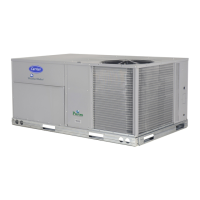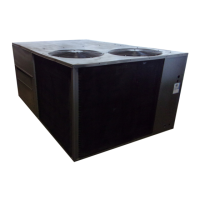33
Alert Codes 110, 111, 140 (Loss of Charge)
— Alert codes
110, 111, and 140 are for circuits A, B and C, respectively.
These alerts occur when the compressor is OFF and the suction
pressure < 5 psig and OAT > –5 F for 1 continuous minute. Use
the Scrolling Marquee to reset the alert. The cause of the alert
is usually low refrigerant pressure or a faulty suction pressure.
These alerts only occur when the compressor is OFF because
the low refrigerant pressure alarms (alerts 133, 134 and 141)
handle this situation when the compressor is operating.
Alert Codes 126, 127, 142 (High Refrigerant Pressure)
— Alert
codes 126, 127, and 142 are for circuits A, B, and C, respec-
tively. These alerts occur when alerts 51, 55, or 59 are active
while the appropriate condensing temperature is greater than
150 F. These alerts reset automatically. The cause of the alarm
is usually an overcharged system, high outdoor ambient tem-
perature coupled with dirty outdoor coil, plugged filter drier, or
a faulty high pressure switch. See Alerts 51, 55 and 59 for diag-
nostic procedure.
Alert Codes 133, 134, 141 (Low Refrigerant Pressure)
— Alert
codes 133, 134, and 141 are for circuits A, B and C, respective-
ly. These alerts occur when the compressor is operating and the
evaporating temperature (converted from the suction pressure)
is less than 20 F for 5 minutes, 15 F for 3 minutes, or 10 F for
1.5 minutes. When the outdoor temperature is less than 40 F, the
above values are reduced by an offset that scales between 0 and
10 as the outdoor temperature goes from 40 to 0° F. These alerts
cause a strike for the respective circuit. These alerts will activate
when the coil becomes frosted. However, during the 15-minute
reset period, the coils will thaw and strike should clear at restart
if there is nothing else wrong with the circuit. The alert resets
automatically. The cause of the alert is usually low refrigerant
charge, dirty filters, evaporator fan operating backwards, loose
or broken belt, plugged filter drier, faulty transducer, excessive-
ly cold return air, or stuck open economizer when the ambient
temperature is low.
Alert Code 140 (Loss of Charge)
— See Alert 110.
Alert Code 141 (Low Refrigerant Pressure)
— See Alert 133.
Alert Code 142 (High Refrigerant Pressure)
— See Alert 126.
Alert Codes 143, 144, 145 (Failure to Pressurize)
— Alert
codes 143, 144, and 145 are for circuits A, B, and C, respec-
tively. These alerts occur when the compressor turns on and the
suction pressure does not drop 5 psig during the first 15 sec-
onds and the condensing temperature does not rise 5 F during
the first minute. These alerts cause a strike for the respective
circuit. The alert resets automatically. The cause of the alert is
usually compressor wiring causing reverse rotation or a faulty
compressor.
Alarm Codes 163, 164, 165 (Circuit Failure)
— Alarm codes
163, 164, and 165 are for circuits A, B, and C, respectively.
These alarms occur when a circuit has 3 strikes. Use the
Scrolling Marquee display to reset the alarm. Investigate the
alarm that caused the strikes to occur.
Alert Code 179 (Com. Failure with ECB)
— This alert occurs
when the MBB cannot communicate with the ECB. This is
usually caused by a wiring problem. Investigate using the Low
Voltage Schematic.
Alert Codes 180 (Com. Failure with Economizer Actuator)
—
This alert occurs when the MBB cannot communicate with the
Belimo Actuator. This is usually caused by a wiring problem.
Investigate using the Low Voltage Schematic.
Alarm Code 404 (Fire Shutdown)
— This alarm occurs when
the shutdown input is either open or closed depending upon its
configuration. This alarm is usually caused by an auxiliary
device that is trying to shut down the unit, e.g., smoke detector.
The configuration for this switch input can be found at variable
FS.SW. Verify that the configuration is set correct, verify the
wiring and auxiliary device. This alarm resets automatically.
Alert Code 408 (Dirty Air Filter)
— This alert occurs when
the Filter Status switch senses a plugged filter for 120 continu-
ous seconds after the indoor fan has been running for 10 sec-
onds. Because the Dirty Air Filter switch can be configured
normally opened or closed, the switch might be open or closed.
The configuration for this switch input can be found at variable
FL.SW. Verify that the configuration is set correct, verify the
wiring and filter status switch. The hose should be connected to
the low side of the switch. This alert resets automatically.
Alert Code 409 (Fan Status Switch On, Fan Contactor
Off) — This alarm occurs when the fan status switch has
sensed that the indoor fan has been on for 10 seconds and the
indoor fan feedback has determined that the indoor fan should
be off. Because the Fan Status switch can be configured nor-
mally opened or closed, the switch might be open or closed.
The configuration for this switch input can be found at Scroll-
ing Marquee: Configuration mode, UNIT submode, FN.SW.
Verify that the configuration is set correctly. Verify the wiring
and fan status switch. The hose should be connected to the high
side of the switch. If the IDF is configured to shut down the
unit when this alarm occurs (Scrolling Marquee: Configuration
mode, UNIT submode, IDF.F = YES), then this alarm can only
be reset manually and the unit is shut down. If the IDF is not
configured to shut the unit down when this alarm occurs
(Scrolling Marquee: Configuration mode, UNIT submode,
IDF.F = NO), then this alarm resets automatically and no spe-
cific control action is taken.
Alert Code 409 (Fan Status Switch Off, Fan Contactor
On) — This alert occurs when the fan status switch has sensed
that the indoor fan has been off for 10 seconds and the indoor
fan feedback has determined that the indoor fan should be on.
Because the Fan Status switch can be configured normally
opened or closed, the switch might be open or closed. The con-
figuration for this switch input can be found at Scrolling Mar-
quee: Configuration mode, UNIT submode, FN.SW. Verify
that the configuration is set correctly. Verify the wiring and fan
status switch. The hose should be connected to the high side of
the switch. If the IDF is configured to shut down the unit down
when this alert occurs (Scrolling Marquee: Configuration
mode, UNIT submode, IDF.F = YES), then this alarm can only
be reset manually and the unit is shut down. If the IDF is not
configured to shut the unit down when this alert occurs (Scroll-
ing Marquee: Configuration mode, UNIT submode, IDF.F =
NO), then this alert resets automatically and no specific control
action is taken.
Alert Code 409 (Fan Feedback On When Not Expected)
—
This alert occurs when the Fan Feedback signal has been On
for more than 5 seconds yet the Fan Power relay is Off. Verify
wiring.
→
202
→

